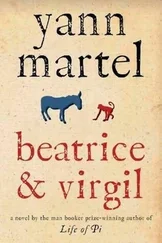Yann Martel - Life of Pi
Здесь есть возможность читать онлайн «Yann Martel - Life of Pi» весь текст электронной книги совершенно бесплатно (целиком полную версию без сокращений). В некоторых случаях можно слушать аудио, скачать через торрент в формате fb2 и присутствует краткое содержание. Год выпуска: 2002, ISBN: 2002, Издательство: Canongate Books, Жанр: Современная проза, на английском языке. Описание произведения, (предисловие) а так же отзывы посетителей доступны на портале библиотеки ЛибКат.
- Название:Life of Pi
- Автор:
- Издательство:Canongate Books
- Жанр:
- Год:2002
- ISBN:9781847674210
- Рейтинг книги:3 / 5. Голосов: 1
-
Избранное:Добавить в избранное
- Отзывы:
-
Ваша оценка:
- 60
- 1
- 2
- 3
- 4
- 5
Life of Pi: краткое содержание, описание и аннотация
Предлагаем к чтению аннотацию, описание, краткое содержание или предисловие (зависит от того, что написал сам автор книги «Life of Pi»). Если вы не нашли необходимую информацию о книге — напишите в комментариях, мы постараемся отыскать её.
Life of Pi — читать онлайн бесплатно полную книгу (весь текст) целиком
Ниже представлен текст книги, разбитый по страницам. Система сохранения места последней прочитанной страницы, позволяет с удобством читать онлайн бесплатно книгу «Life of Pi», без необходимости каждый раз заново искать на чём Вы остановились. Поставьте закладку, и сможете в любой момент перейти на страницу, на которой закончили чтение.
Интервал:
Закладка:
CHAPTER 10
Yet there will always be animals that seek to escape from zoos. Animals that are kept in unsuitable enclosures are the most obvious example. Every animal has particular habitat needs that must be met. If its enclosure is too sunny or too wet or too empty, if its perch is too high or too exposed, if the ground is too sandy, if there are too few branches to make a nest, if the food trough is too low, if there is not enough mud to wallow in—and so many other ifs—then the animal will not be at peace. It is not so much a question of constructing an imitation of conditions in the wild as of getting to the essence of these conditions. Everything in an enclosure must be just right—in other words, within the limits of the animal’s capacity to adapt. A plague upon bad zoos with bad enclosures! They bring all zoos into disrepute.
Wild animals that are captured when they are fully mature are another example of escape-prone animals; often they are too set in their ways to reconstruct their subjective worlds and adapt to a new environment.
But even animals that were bred in zoos and have never known the wild, that are perfectly adapted to their enclosures and feel no tension in the presence of humans, will have moments of excitement that push them to seek to escape. All living things contain a measure of madness that moves them in strange, sometimes inexplicable ways. This madness can be saving; it is part and parcel of the ability to adapt. Without it, no species would survive.
Whatever the reason for wanting to escape, sane or insane, zoo detractors should realize that animals don’t escape to somewhere but from something . Something within their territory has frightened them—the intrusion of an enemy, the assault of a dominant animal, a startling noise—and set off a flight reaction. The animal flees, or tries to. I was surprised to read at the Toronto Zoo—a very fine zoo, I might add—that leopards can jump eighteen feet straight up. Our leopard enclosure in Pondicherry had a wall sixteen feet high at the back; I surmise that Rosie and Copycat never jumped out not because of constitutional weakness but simply because they had no reason to. Animals that escape go from the known into the unknown—and if there is one thing an animal hates above all else, it is the unknown. Escaping animals usually hide in the very first place they find that gives them a sense of security, and they are dangerous only to those who happen to get between them and their reckoned safe spot.
CHAPTER 11
Consider the case of the female black leopard that escaped from the Zurich Zoo in the winter of 1933. She was new to the zoo and seemed to get along with the male leopard. But various paw injuries hinted at matrimonial strife. Before any decision could be taken about what to do, she squeezed through a break in the roof bars of her cage and vanished in the night. The discovery that a wild carnivore was free in their midst created an uproar among the citizens of Zurich. Traps were set and hunting dogs were let loose. They only rid the canton of its few half-wild dogs. Not a trace of the leopard was found for ten weeks . Finally, a casual labourer came upon it under a barn twenty-five miles away and shot it. Remains of roe-deer were found nearby. That a big, black, tropical cat managed to survive for more than two months in a Swiss winter without being seen by anyone, let alone attacking anyone, speaks plainly to the fact that escaped zoo animals are not dangerous absconding criminals but simply wild creatures seeking to fit in.
And this case is just one among many. If you took the city of Tokyo and turned it upside down and shook it, you would be amazed at the animals that would fall out. It would pour more than cats and dogs, I tell you. Boa constrictors, Komodo dragons, crocodiles, piranhas, ostriches, wolves, lynx, wallabies, manatees, porcupines, orang-utans, wild boar—that’s the sort of rainfall you could expect on your umbrella. And they expected to find—ha! In the middle of a Mexican tropical jungle, imagine! Ha! Ha! It’s laughable, simply laughable. What were they thinking?
CHAPTER 12
At times he gets agitated. It’s nothing I say (I say very little). It’s his own story that does it. Memory is an ocean and he bobs on its surface. I worry that he’ll want to stop. But he wants to tell me his story. He goes on. After all these years, Richard Parker still preys on his mind .
He’s a sweet man. Every time I visit he prepares a South Indian vegetarian feast. I told him I like spicy food. I don’t know why I said such a stupid thing. It’s a complete lie. I add dollop of yogurt after dollop of yogurt. Nothing doing. Each time it’s the same: my taste buds shrivel up and die, my skin goes beet red, my eyes well up with tears, my head feels like a house on fire, and my digestive tract starts to twist and groan in agony like a boa constrictor that has swallowed a lawn mower .
CHAPTER 13
So you see, if you fall into a lion’s pit, the reason the lion will tear you to pieces is not because it’s hungry—be assured, zoo animals are amply fed—or because it’s bloodthirsty, but because you’ve invaded its territory.
As an aside, that is why a circus trainer must always enter the lion ring first, and in full sight of the lions. In doing so, he establishes that the ring is his territory, not theirs, a notion that he reinforces by shouting, by stomping about, by snapping his whip. The lions are impressed. Their disadvantage weighs heavily on them. Notice how they come in: mighty predators though they are, “kings of beasts”, they crawl in with their tails low and they keep to the edges of the ring, which is always round so that they have nowhere to hide. They are in the presence of a strongly dominant male, a super-alpha male, and they must submit to his dominance rituals. So they open their jaws wide, they sit up, they jump through paper-covered hoops, they crawl through tubes, they walk backwards, they roll over. “He’s a queer one,” they think dimly. “Never seen a top lion like him. But he runs a good pride. The larder’s always full and—let’s be honest, mates—his antics keep us busy. Napping all the time does get a bit boring. At least we’re not riding bicycles like the brown bears or catching flying plates like the chimps.”
Only the trainer better make sure he always remains super alpha. He will pay dearly if he unwittingly slips to beta. Much hostile and aggressive behaviour among animals is the expression of social insecurity. The animal in front of you must know where it stands, whether above you or below you. Social rank is central to how it leads its life. Rank determines whom it can associate with and how; where and when it can eat; where it can rest; where it can drink; and so on. Until it knows its rank for certain, the animal lives a life of unbearable anarchy. It remains nervous, jumpy, dangerous. Luckily for the circus trainer, decisions about social rank among higher animals are not always based on brute force. Hediger (1950) says, “When two creatures meet, the one that is able to intimidate its opponent is recognized as socially superior, so that a social decision does not always depend on a fight; an encounter in some circumstances may be enough.” Words of a wise animal man. Mr. Hediger was for many years a zoo director, first of the Basel Zoo and then of the Zurich Zoo. He was a man well versed in the ways of animals.
It’s a question of brain over brawn. The nature of the circus trainer’s ascendancy is psychological. Foreign surroundings, the trainer’s erect posture, calm demeanour, steady gaze, fearless step forward, strange roar (for example, the snapping of a whip or the blowing of a whistle)—these are so many factors that will fill the animal’s mind with doubt and fear, and make clear to it where it stands, the very thing it wants to know. Satisfied, Number Two will back down and Number One can turn to the audience and shout, “Let the show go on! And now, ladies and gentlemen, through hoops of real fire …”
Читать дальшеИнтервал:
Закладка:
Похожие книги на «Life of Pi»
Представляем Вашему вниманию похожие книги на «Life of Pi» списком для выбора. Мы отобрали схожую по названию и смыслу литературу в надежде предоставить читателям больше вариантов отыскать новые, интересные, ещё непрочитанные произведения.
Обсуждение, отзывы о книге «Life of Pi» и просто собственные мнения читателей. Оставьте ваши комментарии, напишите, что Вы думаете о произведении, его смысле или главных героях. Укажите что конкретно понравилось, а что нет, и почему Вы так считаете.












